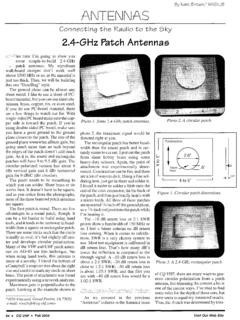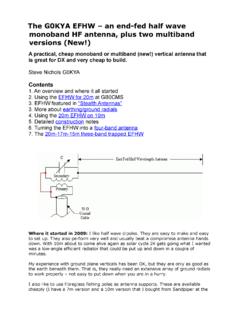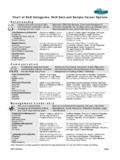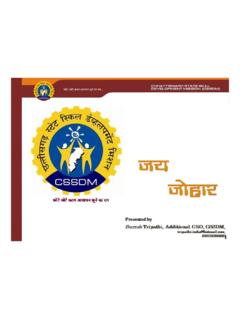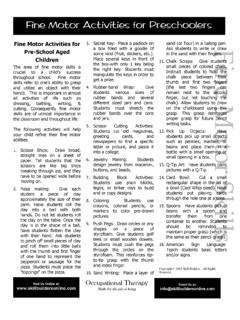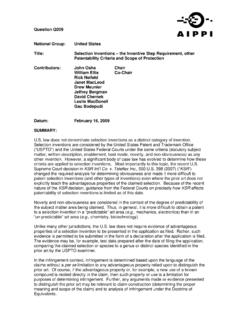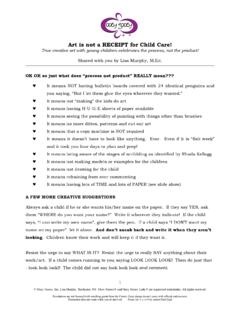Transcription of The Art and Skill - N5DUX
1 William G. Pierpont N0 HFF 1932-20011 The Art and SkillofRadio-TelegraphyA Manual For Learning, Using, Mastering And EnjoyingThe International Morse Code As A Means Of CommunicationWilliam G. Pierpont N HFF What Hath God Wrought! Third Revised Edition July 6, 2 1 Copyright 2 1 William G. Pierpont, N HFFThe Art and Skill of Radio-Telegraphy2 William G. Pierpont N0 HFF 1932-2001 For those who are interested in telegraphy, for those who wouldlike to learn it, for those who love it, and for those who want toimprove their skills in it.
2 William G. Pierpont N HFFThe art and Skill of telegraphy is unique. The psychologists who haveseriously studied those who have developed this Skill have been fasci-nated and challenged to try to understand it. Isn t the very idea ofbeing able to communicate your thoughts to another by means of in-termittent tones something intriguing in itself?The Art and Skill of Radio-Telegraphy currently has the following known trans-lations and web adaptationsFrench: Third Revised Edition: Editor Maurice Colombani-GailleurF6 IIE, : Editor: Jens Henrik Nohns, Z1 CAR, Laerkevej 11, DK-7441 Bording, DenmarkJapanese: 2nd Edition 1997, Published 1 August 2 in Tokyo bythe JARL A1 Club, Editor: Atzu Taniguchi, JE1 TRW, with assistance ofother JARL 1A Club ~a1c/Art& Skill /Art&.
3 Second Revised Edition, First adapted for the World Wide Webby Jon Oates GM VIY for MEGS, rse/n : Second Revised Edition, Second adaptation for the World WideWeb by Ronal G. Bellamy VE6 SIR for Third Revised Edition, last edited July 6, 2 1, Editor, DaveClarke, VE6 LXEnglish Third Revised Edition, last edited July 8, 2 1, is now avail-able for download at the following: , Fred Adsit, NY2 VPreparation and distribution of the text files by Jim Farrior W4 FOK along with hisprogram The Mill book may be freely reproduced and published, but only on a no-profit basis in order to make it as widely available as possible to thosewho need N HFFThe Art and Skill of Radio-TelegraphyWilliam G.
4 Pierpont N0 HFF 1932-20013 ContentsContents3 Preface8 Introduction8Is the Radio-Telegraph CodeObsolete?10 Learning the Morse Code - AnOverview11 Where we are going11 Chapter 113 How to Go About it Efficiently13 This Chapter Is A Summary To Prepare You ToLearn13 How Long Will It Take Me To Learn17 Chapter 217 Principles of Skill Building and Attitudesfor Success17We Are Building A Set Of Habits17 Relax18 Develop A Good Mental Attitude19 Stage One Learning The A-B-C s19 Stage Two - Practice20 More About Attitudes For Success21 Picturing Success Is Strong Preparation For It21 Chapter 323 Part I.
5 Laying the Foundation23 Let s Begin With The A-B-C s23 Motivation24 Learning The Morse Code Is Similar ToLearning To Read25 The Morse A-B-C S Are Patterns Of Sound26 Part II: Laying the Foundation26 Delayed Perception And Instant Recognition26 Listen Only To The Best Quality Of Code27 Getting Started27 What Characters Shall We Begin With28 Methods To Go About Teaching28 Part III: Laying the Foundation30 Chapter 432 Building The First Floor On The SolidFoundation32 Instant Recognition32 Anticipating32 What Kind Of Material To Practice33 Other Ways34 How Long And What Kind Of Practice34 Getting Stuck36 The 1 Most Common Words In English36 Passing Examinations37 Chapter 537 Practice To Gain Proficiency37 How Far Do You Want To Go37 Make Each Practice Period A Step Forward39 Kinds Of Practicing39 Listening Practice39 Word Recognition Practice40 Copying Practice41 Sending Practice41 Mental Practice42On
6 The Air Practice42 Chapter 643 How Fast43 The Wrong Well43 Copyability43 Fast Enough To Communicate Satisfyingly44 The Proficient Operator45 Your Own Goal45 Shortening Things Up46 Chapter 748 Listening or Reading48 Listen48 Concentrate50 Learn To Hear - Words As Words50 How Can We Learn To Do This51We Must Listen At Higher Speeds To Improve53 The Art and Skill of Radio-Telegraphy4 William G. Pierpont N0 HFF 1932-2001 Missing Words53 Long Words53 Decapitated Words53 Broken Words53On-The-Air Listening55 Chapter 855 Copying Getting it written down55 Practice With Familiar Text Helps56 Pay No Attention To Any Errors57If You Want To Become More Proficient57In The Beginning58A Better Way58 What Makes Sense Is Easier60 Conquering Our Fears Of Losing Out61 Other Suggestions62 How Long Shall I Practice62 Fading, Static.
7 Interference and or Poor Fists62 Correcting Imperfect Copy63 Other Observations6398 Of The 1 Most Common Words64 Chapter 964 Sending and the Straight Key Part I64 Quality Of Sending64 Keying And What It Means65 The First Morse Key65 Recommendations To The Beginner65 The Straight Key66 The American Straight Key And Its Use67 Gaining Skill , Errors, and Automaticity68 Personal Characteristics, Fists69 Chapter 969 Sending and the Straight Key Part II69 KEYS69 The Traditional British Key And Its Usage70 Using A Straight Key71 Glass Arm72 Tests for Proper Operation of a Hand-Key73 What Is It That Makes a Good Hand-Key?
8 73 Chapter 1 74 Other Keying Devices And Their Use74 All Kinds of Keys75 Other Kinds Of Manual Keys75 The Bug76 Using A Bug76 Setting the Adjustments of a Bug77 Sending With A Bug78 Keyers78 Keyboards79An Interesting Bug80 Chapter 1180 Further Development of Skills80 Higher Skills80 Truly High-Speed CW Awaited Electronics81 Looking Backward And Forward81 The Skilled Operator83 Faster Faster - Faster83 Reading Versus Copying Skill84 The Sound Barrier84 How Can Such Skill Be Developed85 Factors Needed To Get There86 Who Can Do It87 Amateur High Speed Clubs88 Chapter 1289 How Long Will It Take To Learn89 Marshall H.
9 Ensor s Code Course89 Another Example - Compounded By Handicaps91 More Examples93 Some Outstanding Examples Of Effectiveness93 Determination and Persistence94By Contrast94 Chapter 1395 The Role of Memory in Telegraphy95 Some Further Questions and Thoughts96 Chapter 1497 The Ear97 Pitch Of CW Signal97 Sensitivity To Duration Of Sound98 The Art and Skill of Radio-TelegraphyWilliam G. Pierpont N0 HFF 1932-20015 The Ear Can Often Make Sense Out Of PoorSending98 The Trained Ear Can Discriminate BetweenSignals99 Headphones Are Superior To A Speaker99 Chapter 1599 Timing99 Timing Is The Heart Of The Code99 The Basic Units100 Relative Duration And Spacing Are VeryImportant100 Irregularities In Timing101 Chapter 16103 Other Methods103 Personal Computers And Keyboards For Self-Learning103 Many Computer Programs Are Excellent103 Growing Up With Hearing It104 Learning By Listening To High Speed Code104 Further
10 Comments On Gaining Speed104 Sleep Learning105 Another Suggestion That Has Worked105 McElroy s Course and His Claims For It106 Chapter 17106 Common Errors and What To Do AboutThem106 Chapter 18107 Computer Programs And Tapes ForLearning And Improving Skill In Code107 Morse University107 SuperMorse By Lee Murrah, WD5 CID108 Morseman+ By Robin Gist NE4L/ZF2PM108 GGTE Morse Tutor Gold108 The Mill. by James S. Farrior, W4 FOK108 The Morse Tutor Program109 NuMorse by Tony Lacy G4 AUD110 Code Tapes For Learning And For OtherPurposes110 Chapter 19111A Brief History of Morse Telegraphy Part I111 The Original Morse Code112 Who Invented What We Call The Morse Code112 Vail s Thinking115 Chapter 19117A Brief History of Morse Telegraphy Part II117 The Original Morse Code Modified In Europe117 Equipment118 Early Day Operators Up Through The CivilWar119 Operators After The Civil War119 The Introduction Of Wireless120 When Were The Terms Dit And
